- The Evergreen Coat Project -
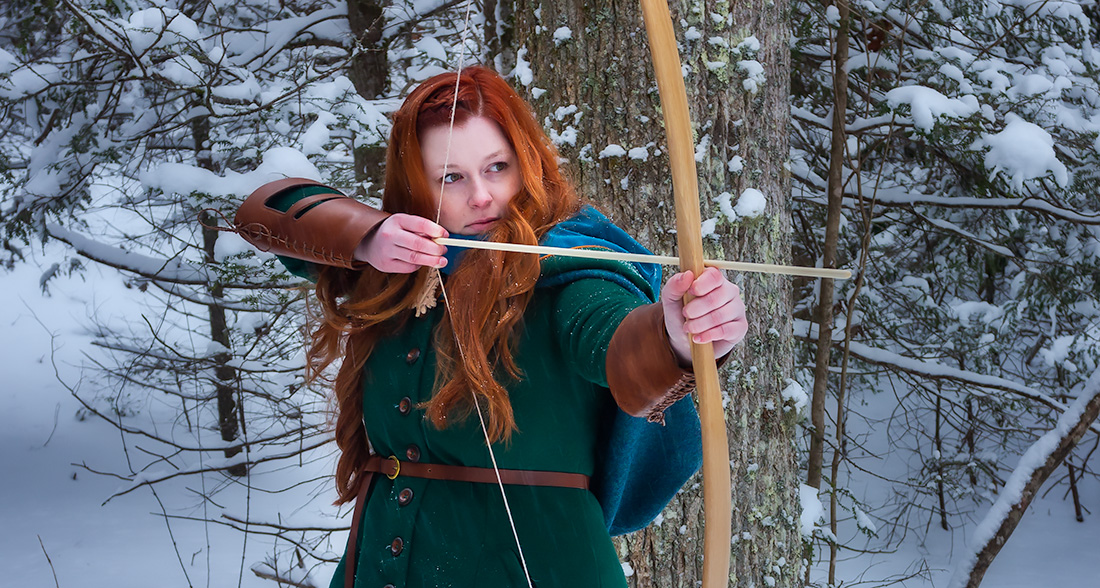
- The Evergreen Coat Project -

It seemed like a good idea at the time.
And it was - it just took 15 years to confirm that.
It all started at the M. H. de Young Museum of Art in San Francisco in 2006,
where I saw the 1890 painting "Celtic Huntress" by George de Forest Brush:
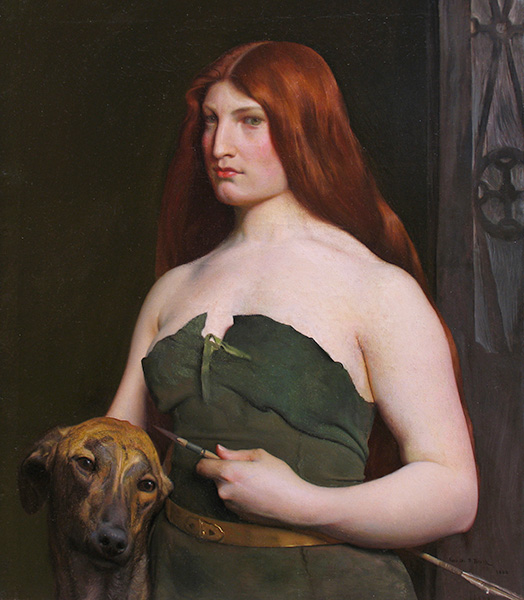
This image stuck with me, and I began to consider painting my own version of a similar sort of character - someone who could have emerged from a Scottish legend, let's say. But I envisioned a very different image, involving an elaborate, green and blue winter coat that I would design, to be worn by a model in a landscape thickly covered with fresh-fallen snow. To achieve this with any credibility, I would have to create the clothing and the props, and find an appropriate model, and the entire endeavor would have to converge with some serious snowfall.
Let me just tell you: conjuring something like that isn't easy. Or cheap. Or quick. But bringing things to life that do not yet exist is what we artists do, and sometimes you just have to pull through.
So, flash-forward to 2013. By then, I had moved to the Smoky Mountains of East Tennessee, and was on the lookout for a model with flaming red hair, green eyes, strong features, and an abiding love for winter. She turned out to be a young lady named Madison, who at that time was still in high school. I discovered her through the work of a talented photographer, Kalani Ann Odum of White Creek Photography, who had produced a portfolio of photos of Madison (two examples below).
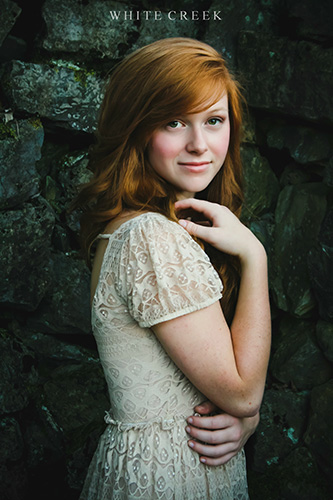
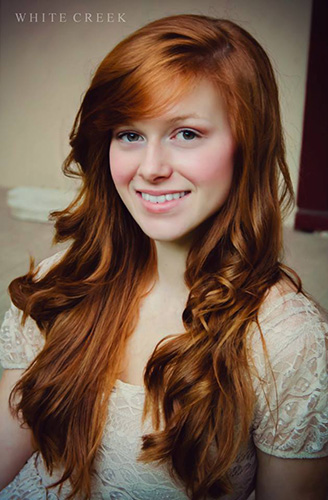
Seeing these images, I was pretty sure that Madison could be the one that I'd been looking for. I e-mailed Kalani to ask if she might tell Madison's family about me and my project, and give them my contact information. She graciously did so, and within a few weeks I was meeting Madison and her mom at a Cracker Barrel in Maryville, Tennessee.
Had they known exactly what they would be getting into, I doubt that they would have agreed to it. But, then, I didn't know exactly what was ahead, either. I naively anticipated a duration of two years to complete the project.
In reality, it took SEVEN years. By the time that I finally photographed Madison on a snowy morning at Roan Mountain State Park in February of 2021, she had graduated from high school, completed nursing school, been married, and was working as an emergency room nurse.
In the meantime, I had found a professional dressmaker to produce my imaginary coat. She was Tara Nyanga of Sugarcane Studios in Asheville, North Carolina. Yeah, that's right - I live in Tennessee, and Tara's studio is in North Carolina. It was a two-and-a-half hour drive to get there, and I had to make that trip at least four times. Maybe it was five, I can't remember. Madison and her mom actually agreed to go there, too - TWICE - for fittings.Why? Because they're angelic beings, that's why. And apparently they liked me or something.
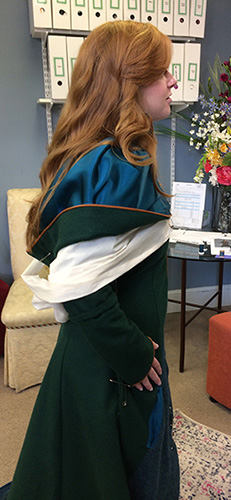
Left: Madison trying on the unfinished coat in Tara's studio; right: the coat nearing completion.
Below: the coat finished, in my own studio at home, with and without the arm bracers that I made for it.
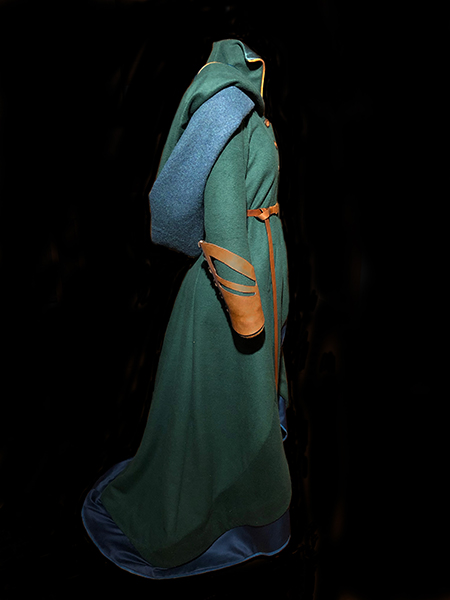
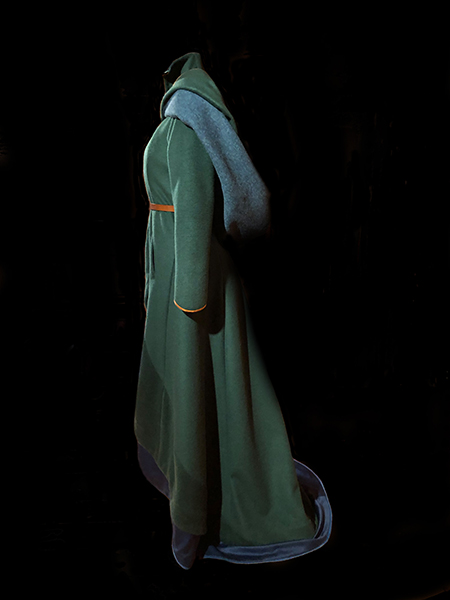
Tara skillfully put this thing together, despite the fact that it was weird and constantly required an evolutionary process of rethinking as we encountered unforeseen problems.
It was made from a variety of fabrics, mostly silks and wools. Some of the most beautiful wool came directly from Scotland, manufactured by Harris Tweed in the Outer Hebrides Islands; I could find nothing of equal quality locally. Ultimately, the garment involved so many layers of heavy fabric that the finished product weighed nine pounds.
As a guide for Tara, I produced digital paintings in which I rendered images of what the coat might look like by painting directly over photographs of Madison; see the two examples below. The coat called for two nested hoods that could function independently of one another, a collar with silk edging that could hold a specific curve, and other difficult requests. Why two hoods, instead of one? Because it was unusual and less predictable, and provided an opportunity to introduce more dynamic layers, shapes, color combinations, and textures.
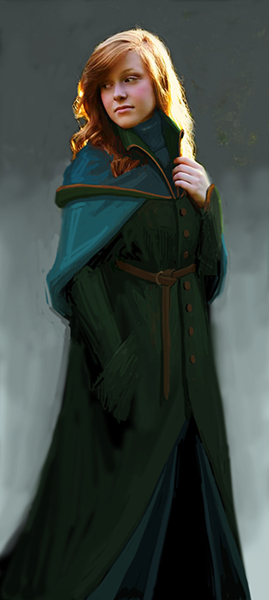
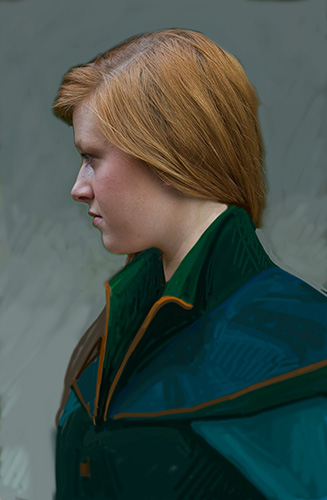
The production process was delayed for years by a number of factors beyond anyone's control, including deaths in my family and uncooperative weather in Tennessee (no snow for two winters in a row). But then the winter of 2021 came around, and the snow returned with it. The coat was ready and Madison had two days off from work at the very moment when a snowstorm was forecast for her area. The stars aligned and all of the moving parts came together in ways that seemed like something more than mere chance. I drove to Madison's community in north-east Tennessee, stayed in a hotel overnight while the snow fell, and then we ventured out the next morning to Roan Mountain.
The roads were...not great. But we made it in and out of the park without incident, and witnessed one of the most beautiful snowfalls imaginable. The entire area was covered with at least five inches of the freshest, untouched snow. Winds gusting to 40 mph had been forecast as a possibility, which would have ruined everything and made the shoot impossible - but the winds did not materialize. Instead, snow fell gently during most of our time there, and it accumulated beautifully on the fabrics of the coat and on Madison's hair. It was a genuinely enchanted event, as I think the photos amply prove.
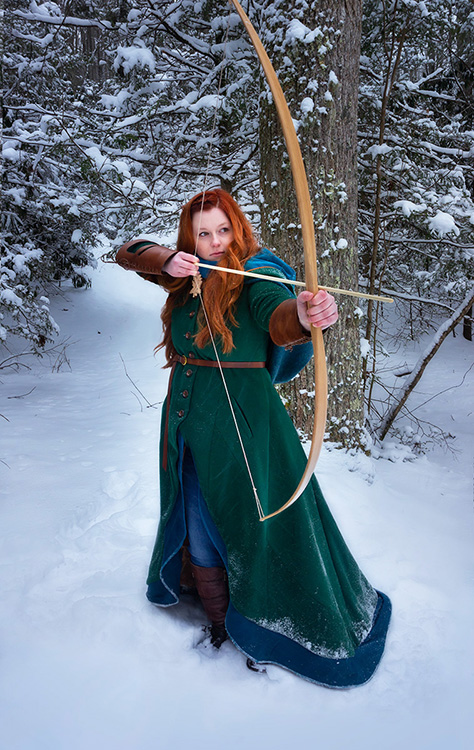
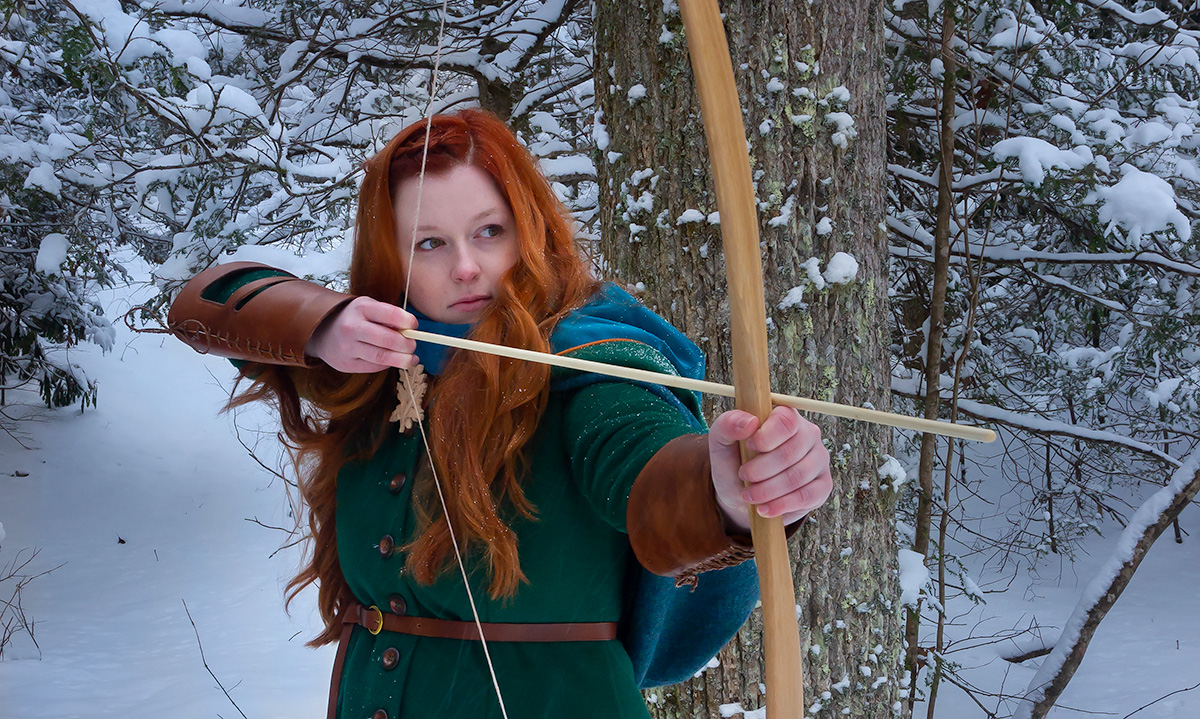
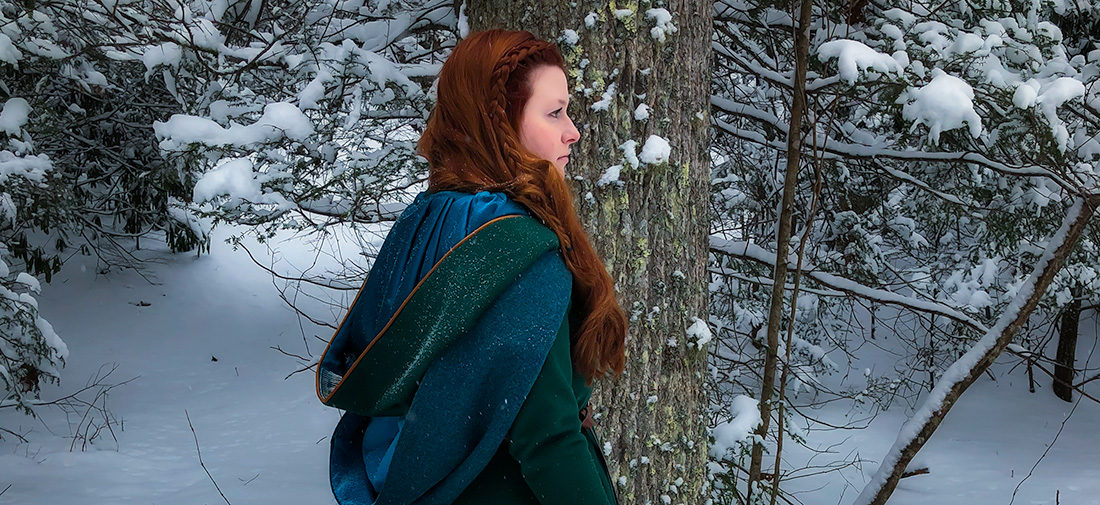
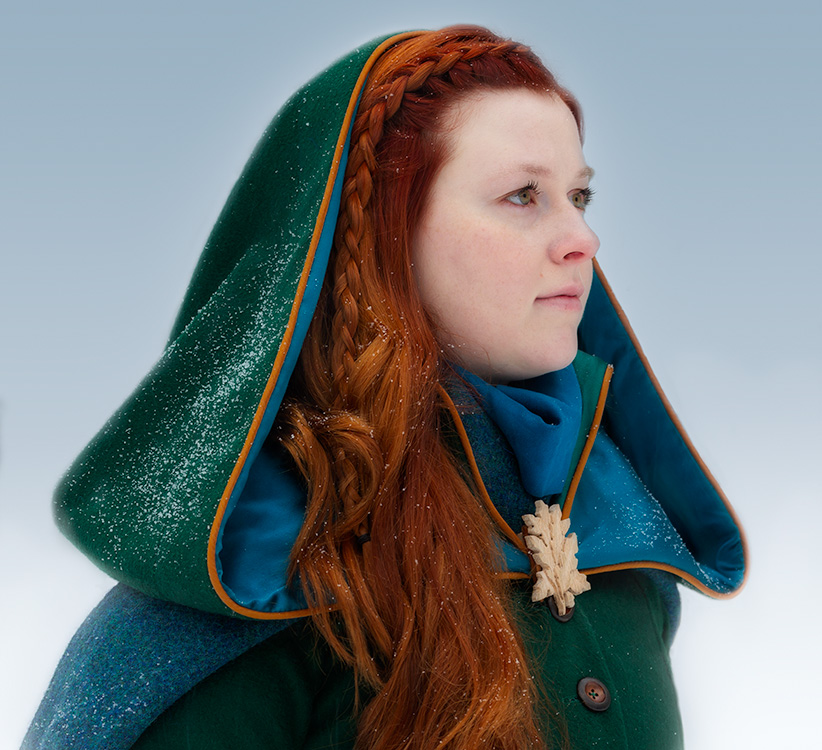
Above and below: A last-minute addition to the outfit was a wooden clasp, which I carved from oak wood to represent a cluster of oak leaves, to be placed at the central intersection of the hoods and collar. That area was the weakest part of the garment's design, both visually and structurally - the wooden clasp helped to reinforce this stressed area by providing a rigid support behind the top button, while also adding a decorative focal point in an otherwise empty space.
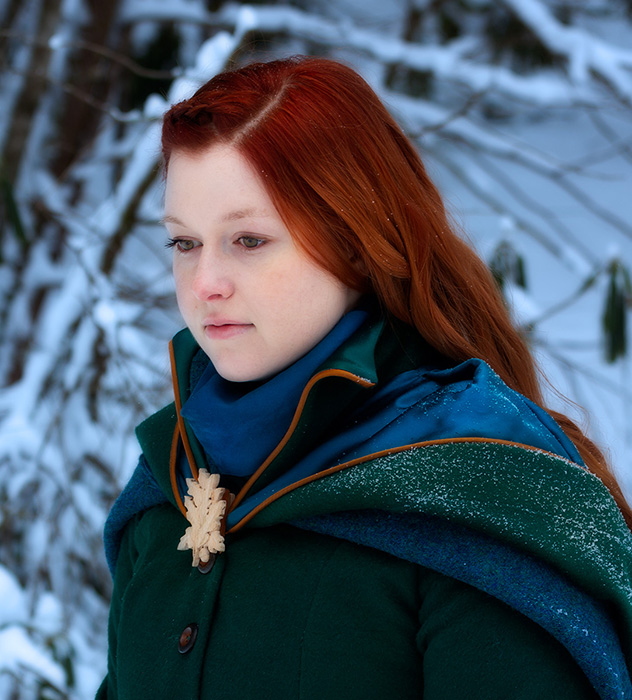
When I say that the clasp was a "last-minute" addition to the ensemble, I mean that literally - I worked on it in my shop until 4 am the night before leaving for Madison's town, and I worked on it again with hand tools at the hotel during the evening before our photo-shoot the following morning. Despite the late fabrication, it performed its functions even better than I had hoped, and was a welcome solution to a problem that I had puzzled over for a long time.
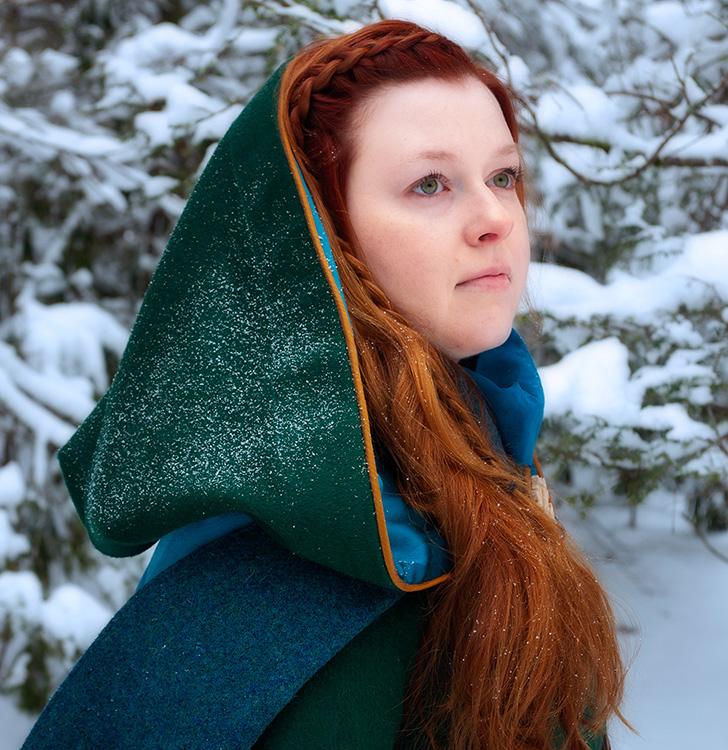
The shots above also illustrate the many color combinations that came together beautifully through the careful selection of both the fabrics and the model who would wear them. Note that the orange silk edging on the hood matches the highlights of Madison's hair nearly exactly; also, the green of her eyes is a very close match to the green color of the main body of the coat and hood. Those relationships were not accidental, although I was lucky to have found both a model and a set of fabrics that would pair so well.
The wool fabric that I ordered from Scotland forms the lower hood (covering her shoulder in the shot above); that fabric is flecked with blue and green hues that perfectly match the blues and greens found elsewhere in the garment, to ensure a color harmony throughout.
The dark blue/green palette of the coat was intended to provide maximum color contrast against Madison's hair, to call primary attention to that feature. She partially braided her hair very beautifully, even while allowing most of it to flow freely. She also agreed to grow her hair to great length, just because that was what I wanted.
A hair comb woven into the edge of the upper hood empowered it to stay in place perfectly, no matter where we placed it on Madison's head. With the colors of the fabrics seen in direct association with the richness of her hair, the results were stunning:
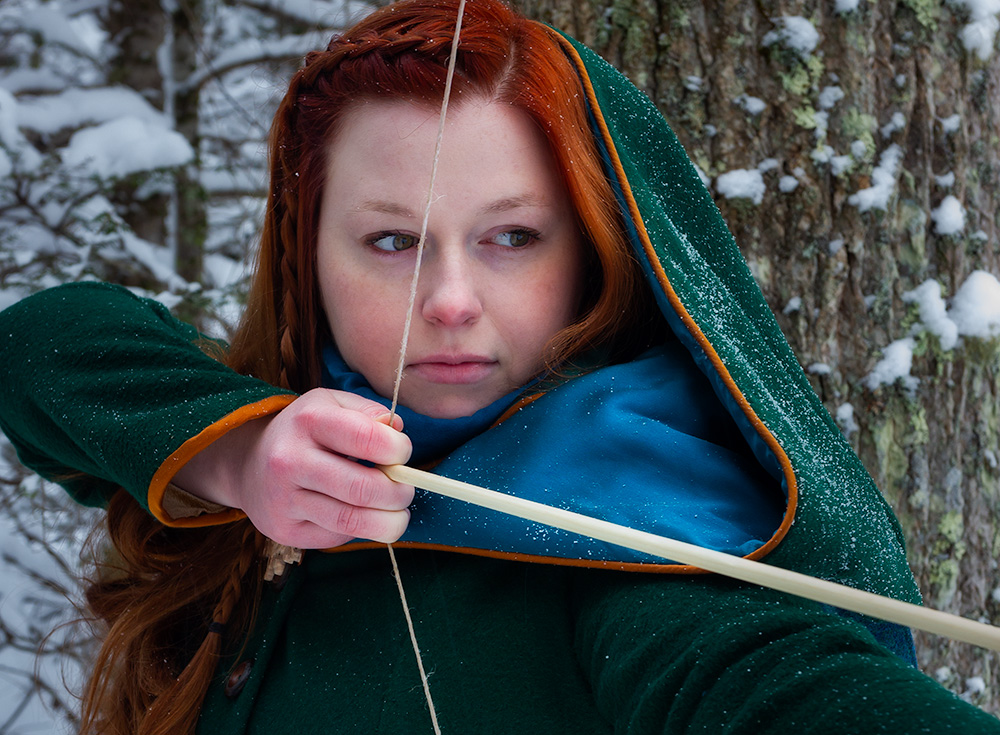
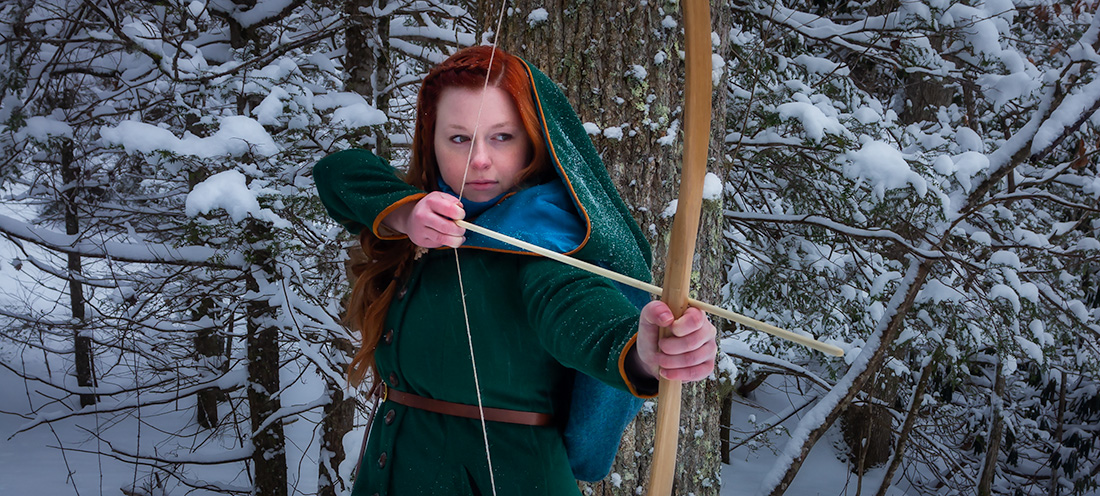
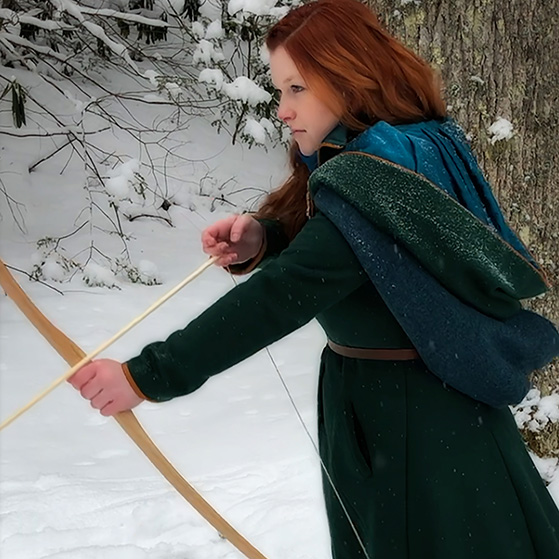
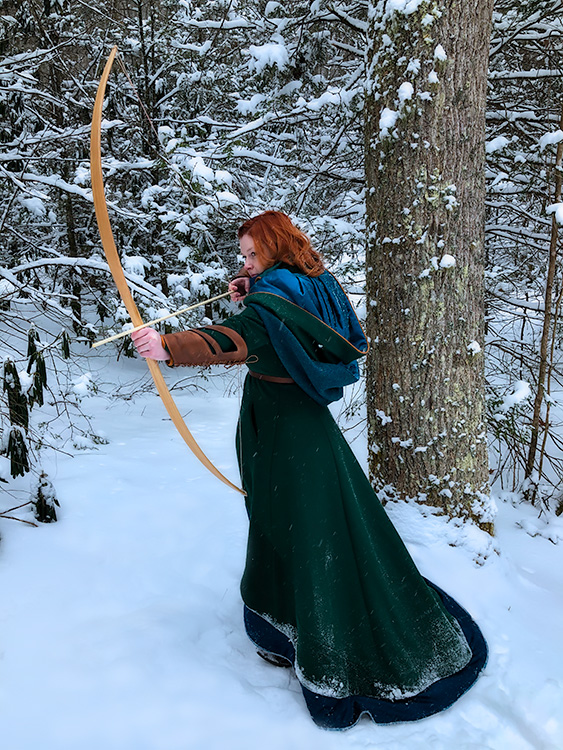
Above and below: Tara Nyanga's experience with clothing led her to suggest a critically important design change to the coat, which proved to be very wise - she recommended that the coat should be long enough to trail on the ground for some distance behind Madison, which allowed the lower half of the garment to develop a wide, flowing shape that would balance the heaviness of the dual hoods across the shoulders. Brilliant thinking, Tara: it worked beautifully. Flowing across the surface of the snow, the train produced interesting shapes, while also picking up a fine film of snow which helped to integrate the garment with the environment.
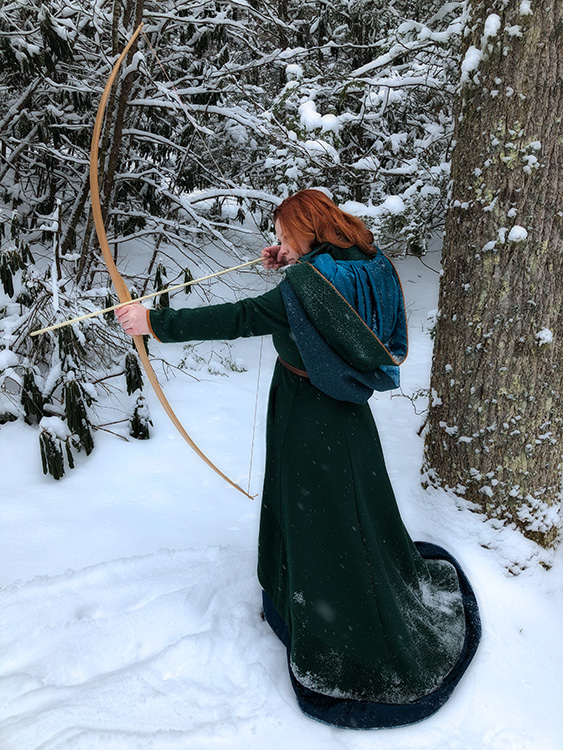
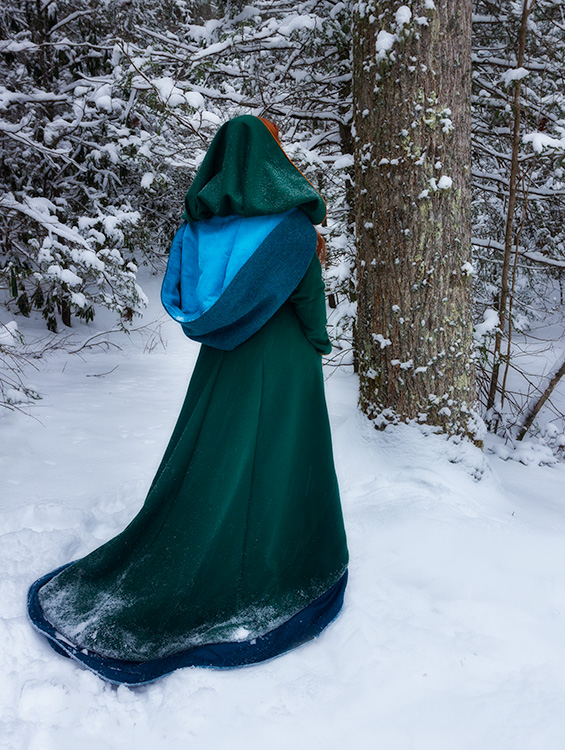
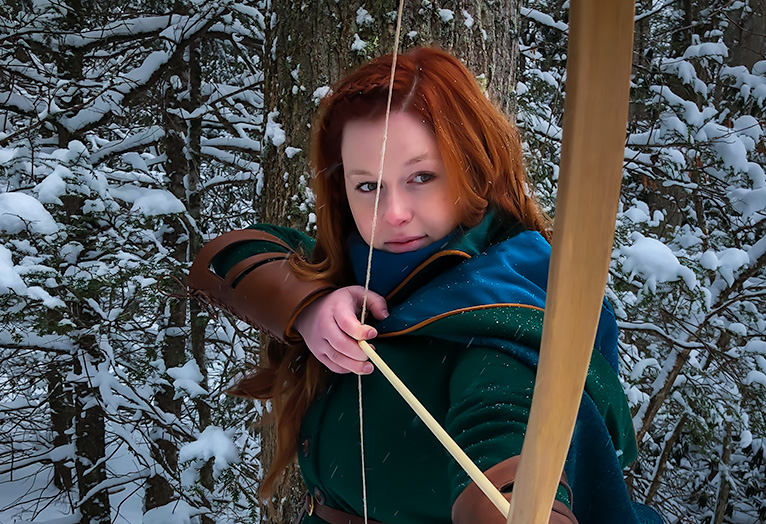
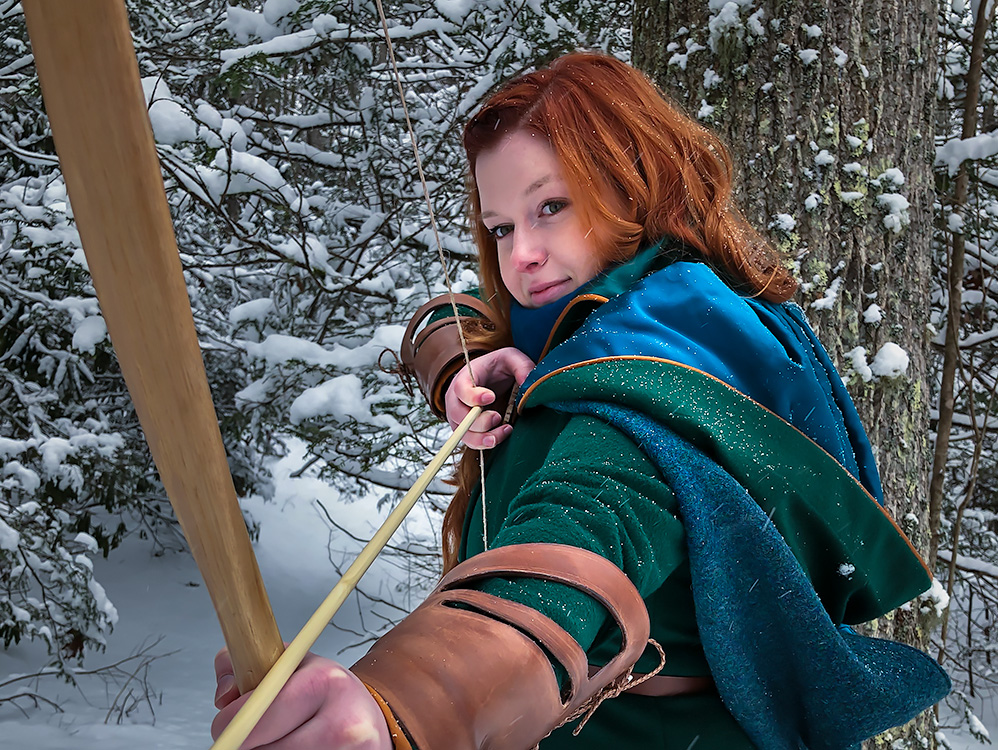
Although I previously had no experience with leather-crafting, I turned to YouTube to learn the basics so that I could produce the leather arm bracers seen above. I cut windows into these items to allow the color of the underlying fabric to show through a bit. I also shaped them to compel the leather to match the shape of an arm more naturally; I did this by wetting the leather and then wearing the bracers myself, gradually working them with wooden tools until they had subtly conformed to the contours of my arms. When dry, the leather retained this form.
The bracers were tricky to make because you have to cut out a flat shape, and then curve it form a cylinder that is narrower at one end than at the other. I made several versions with paper until I seemed to have it correct. The final pattern in leather can be seen below:
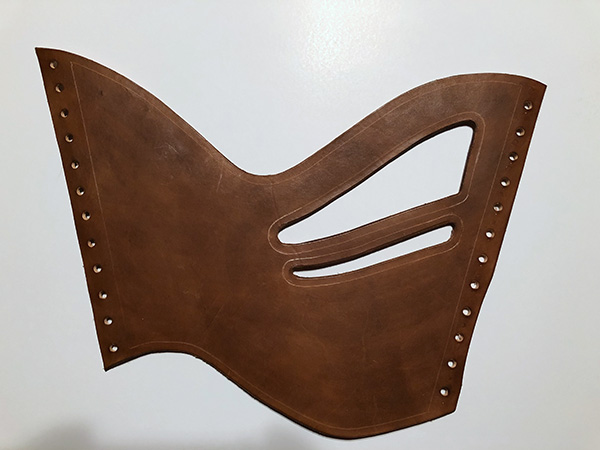
They were ultimately laced together with leather cord. And if you think that lacing them up was a simple matter, guess again: it turns out that there are over 60 ways to lace an item like this, and I learned several of them before settling on one solution.
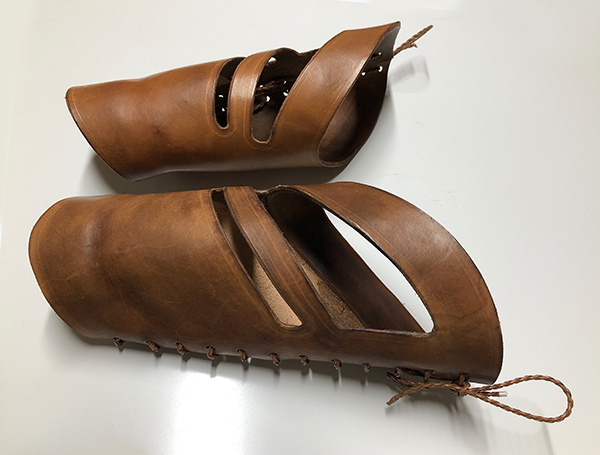
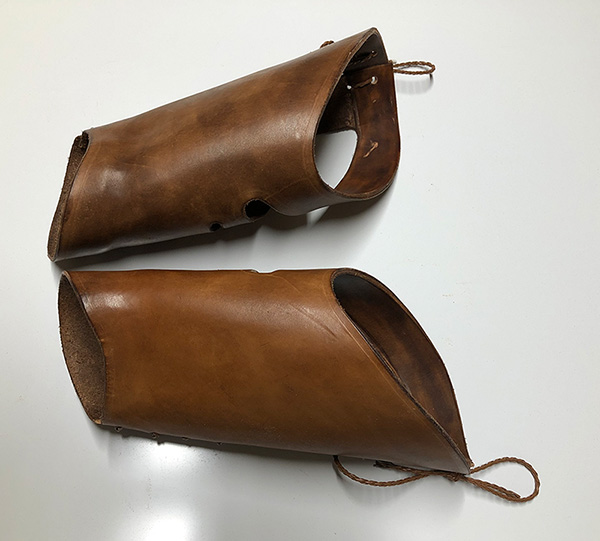
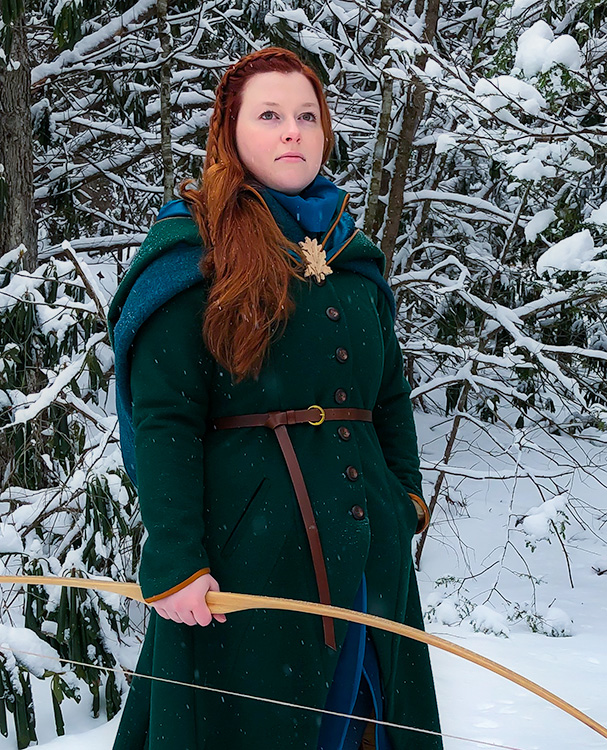
Another element that I made from scratch was the extra-long, knotted belt seen above. I had tackled this as my first leather-crafting project, since it was a bit easier to fashion than the arm bracers:
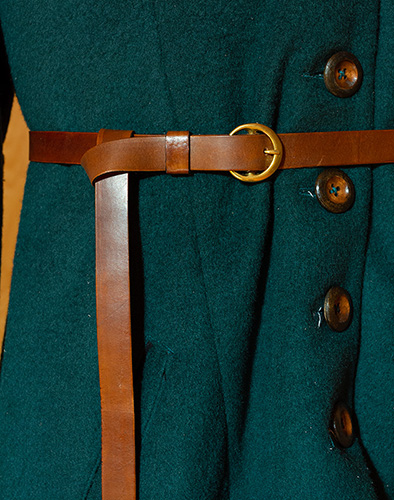
Even the coat's wooden buttons were hand-retouched to make them integrate better with the entire garment; the original buttons were the right size and shape, but were too bright and orange. They were intended to blend in with the main color of the coat more effectively - so I sanded off the original finish, and then stained them a darker color, leaving just a touch of the original orange to show through near the center of each.
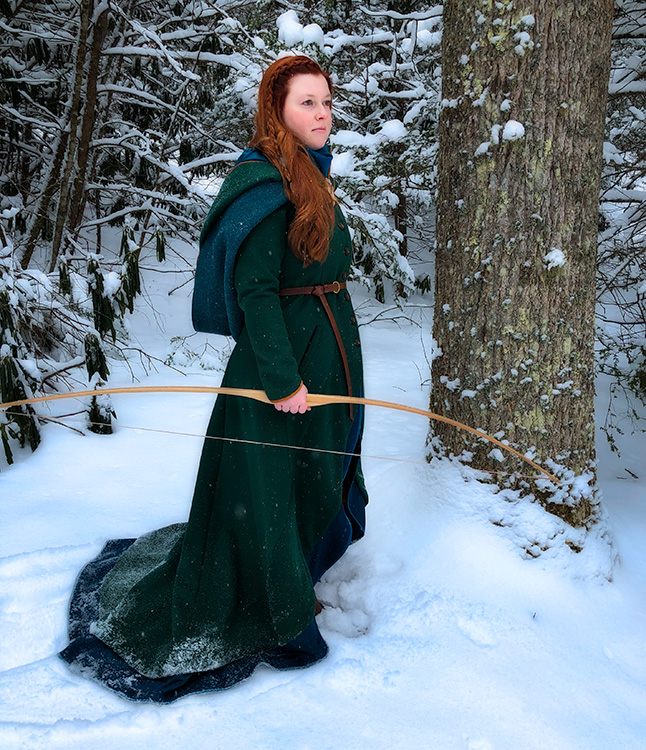
Madison's bow entered the project as an inexpensive purchase from a local antique store. It had seen better days at the time of purchase, and easily came apart into four pieces when I began to refurbish it - but I quickly had it reassembled with a fresh coat of glue, which made it very strong again.
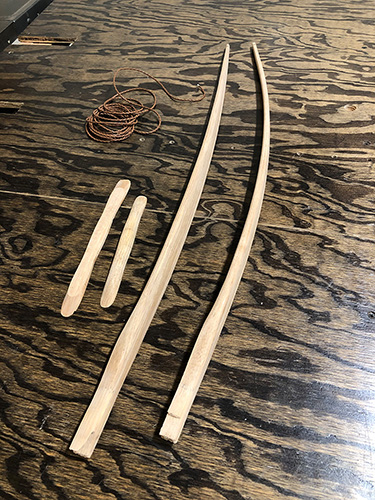
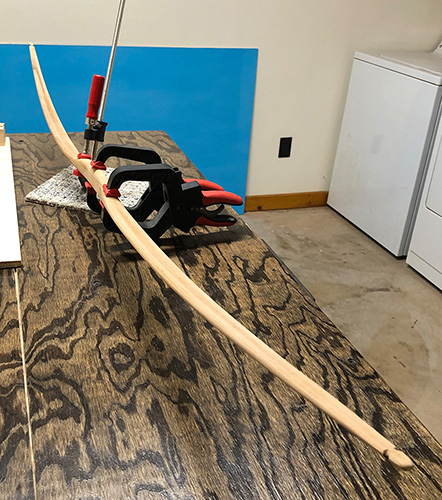
I then thoroughly sanded it to a smooth finish, and gave it a fresh coat of clear polyurethane. Just like new. Then I consulted YouTube again to learn how to tie archery knots and to properly string a bow. Some jute twine provided my bowstring, which I waxed heavily to give it the clean look of real bowstring.
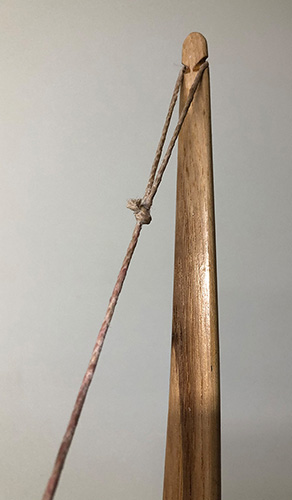
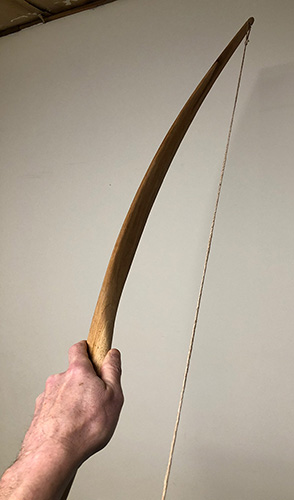
It actually worked very well and was quite capable of shooting an arrow - which is why we used a harmless wooden dowel, instead, since I didn't want to get shot accidentally during the photo-shoot. In the paintings that I'll produce from these images, I'll simply give the dowel an arrowhead and some feathers through the magic of artistic license.
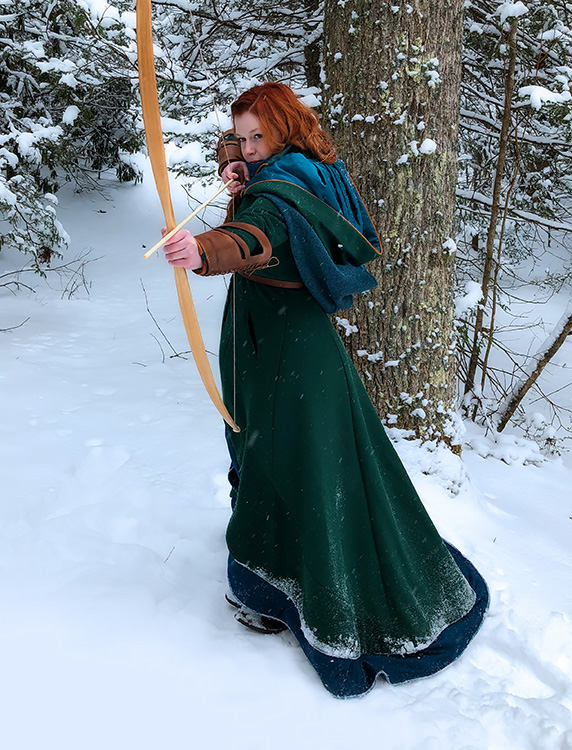
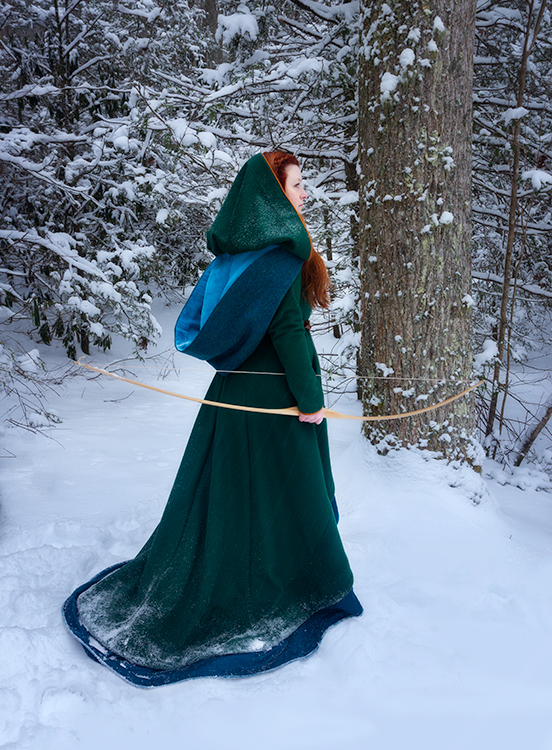
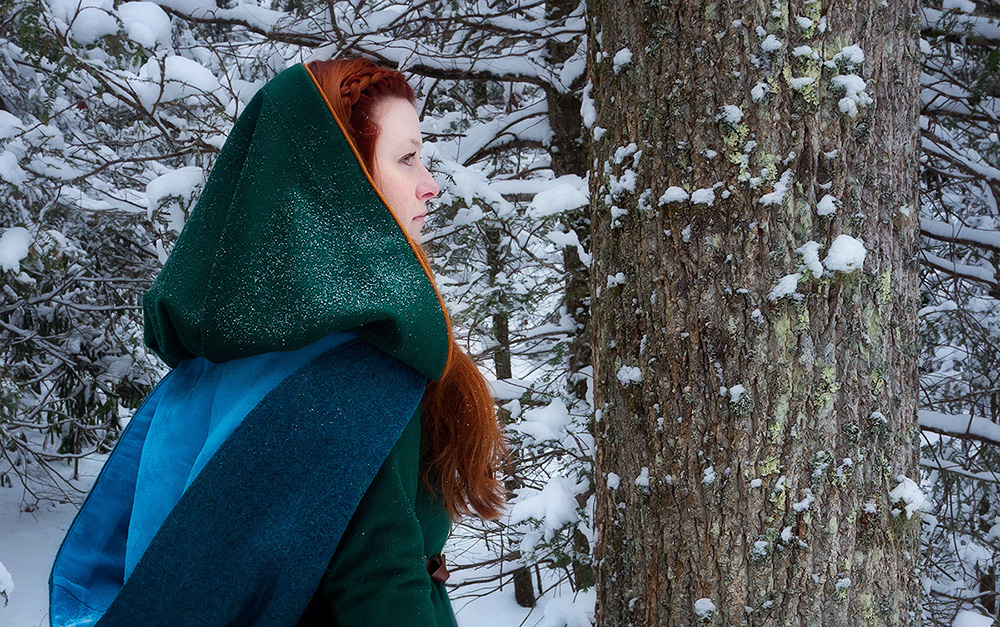
All in all, it was a worthwhile effort, and a relief to see this project end in such a gratifying fashion after so many years of work, expense and doubt. Now, it's time to paint.
I would like to thank Kalani Odum for facilitating the meeting between myself and Madison; everything that transpired flowed from that act of kindness; if you need a portrait photographer in north-east Tennessee, she's an excellent choice: White Creek Photography.
Also, thanks to Tara Nyanga for making the coat a reality; if you're in need of dressmaking services in the Asheville area, I commend her to you highly: Sugarcane Studios.
And I'm eternally grateful to Madison and to her mom, Misty, for putting up with me through all of this; they went far above and beyond the call. I would also like to note the integral role that was played by Madison's former boyfriend, Justin Nixon, who is now very tragically deceased; Justin accompanied Madison and her mom on our first meeting, and his social skills were vitally important that day as an ice-breaker between us all. Hilariously, his first blunt question to me was, "Kit, I have to ask: are you an axe murderer?" A fair question; I still laugh about that every time that I think of it. He is sorely missed.
Return to the Wardrobe Projects page